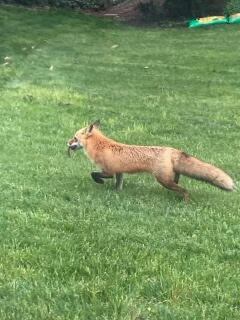Increasing Presence of Foxes in Urban Areas
In recent weeks, residents in the Kansas City metro area have reported spotting foxes near their homes. This has led to concerns about safety and prompted questions about how to coexist with these wild animals. While some may feel uneasy, experts suggest that the risk of harm from foxes is minimal.
Amy Keigher, a natural resources agent at Johnson County’s K-State Extension, explains that foxes are typically more afraid of humans than the other way around. As a nocturnal species, they are often active during the night and tend to avoid human interaction. However, encounters can happen when their schedules overlap with those of people, especially in the early morning or late evening.
“Although it’s rare, the risk of them causing harm to your pets or children is very low,” said Keigher. “The best approach is to maintain a safe distance and observe them from afar. They are fascinating creatures, and learning about them can be a rewarding experience.”
Keigher emphasized that foxes are small animals, which makes them unlikely to attack pets or children. However, she does offer advice for pet owners who find a fox den on their property. Creating a physical barrier between the den and pets is crucial to prevent unwanted interactions.
Signs to Watch For
While most foxes are harmless, there are certain behaviors that could signal potential danger. Keigher warns that if a fox moves slowly or approaches a person directly, it may be a sign of distress or illness. In such cases, it’s best to keep a safe distance and avoid direct contact.
She also highlights the challenges that urban environments pose to wildlife. As cities expand, animals like foxes must adapt to new surroundings, often facing life-threatening obstacles. Roadways, for example, are a common hazard. Many foxes are hit by vehicles, while others are captured by humans who may choose to relocate or euthanize them.
“This was their home, and as humans develop these areas, they’re forced to live in a world that’s not designed for them,” said Keigher. “It’s a dangerous place for them, and we need to find ways to coexist without causing harm.”
Learning More About Local Wildlife
For those interested in gaining a deeper understanding of local wildlife, K-State Extension offers educational opportunities. A class on foxes will be held at 6 p.m. on September 22. This event provides an excellent chance to learn about the behavior, habitat, and role of foxes in the ecosystem.
Keigher encourages people to take a more informed approach when encountering wildlife. Rather than reacting out of fear, she suggests observing from a distance and respecting the animals’ space. By doing so, communities can foster a safer and more harmonious relationship with the creatures that share their environment.
Tips for Coexisting with Wildlife
- Keep a safe distance from foxes and avoid direct interaction.
- Create barriers between pets and any nearby fox dens.
- Be aware of unusual behavior, such as slow movement or approaching humans.
- Support local efforts to protect wildlife and promote coexistence.
- Attend educational events to learn more about local animals and their habitats.
By understanding the challenges faced by urban wildlife and taking proactive steps, residents can help ensure the safety of both people and animals. With education and awareness, it’s possible to create a balanced environment where wildlife can thrive alongside human communities.







